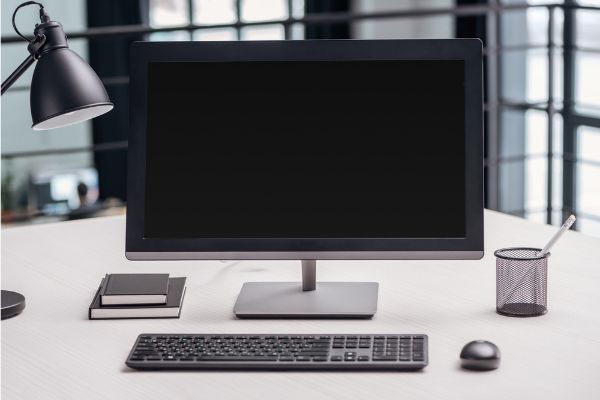Disclaimer: This post may contain affiliate links, meaning we get a small commission if you make a purchase through our links, at no cost to you. For more information, please visit our Disclaimer Page.
Modern monitors provide viewers with an excellent way to view text, images, and video. They can handle high-definition output, and they have settings that allow the color schemes of the backgrounds to become as vibrant as possible.
With advancements in visual technology, some potential issues can crop up from time to time. One of these issues is what enthusiasts might refer to as backlight bleed. Backlightbleed happens when light that is not needing for whatever you’re viewing is not blocked completely.
Some users may wonder if this bleeding effect goes away over time, or if can become even more problematic. We’ll get into the specifics of how backlight bleed works, and we’ll tell you how you might minimize or fix the issue as well.
Table of Contents
Should I Be Worried About Backlight Bleeding?
When you’re viewing images or video on a modern liquid crystal display—one of the most common types of monitors for TV and computers today—you may notice that the entirety of the surface of the screen is backlit. This effect happens behind the major source of the monitor’s lighting itself.
Although the entire screen is lit up, it also has provisions for blocking out light that is not needed at a particular time or for certain imagery. However, sometimes this blocking does not happen as it normally should, and this is when the bleed occurs.
Some users may wonder if they should be concerned about backlight bleeding. In the technology world, the honest answer is often that it depends on several factors, and these factors can be different for everyone. However, let’s look at what backlight bleed is supposed to do. Later, we’ll get into how the bleed might affect performance for particular tasks.
If you want the absolute best, high-quality visuals with zero perceptible imperfections at all, you might be concerned about backlight bleeding. We should point out, though, that perception plays a key role here. Even if you are using a high-range LCD monitor, it is likely that you will deal with a tiny amount of backlight bleed in the course of your usage.
This is because the manufacturing processes involved in modern monitors don’t necessarily make it so that they can block all unnecessary light all the time. The range of opacity and the materials that are common in the monitors just don’t have this capability.
All that said, manufacturers do account for backlight bleed, and most of the good ones will do their best to reduce backlight bleed as much as they can when they test their products. Mostly, this should be sufficient for many viewing or gaming experiences.
Everyone is different, and you may apply your own standards to the acceptable level of backlight bleed you want to tolerate. As a good rule of thumb, you don’t need to worry that much about backlight bleed if it is not generally perceptible to your eye, or unless it is really affecting your experience.
Much of the backlight bleed that is in a monitor is not at a high enough level to be noticeable most of the time.
Can Backlight Bleed Get Better Over Time?
If backlight bleed is a noticeable issue that is keeping you from enjoying your media fully, you may wonder if it can get better over time. For the purposes of our discussion, we will assume that users might wonder if backlight bleed might reduce itself on its own, with no input from them. The precise nature and causes of backlight bleeding can be complex. We can’t guarantee that all backlight bleeding will improve over time, but we’ll get to what you can do about that in another section.
What we can say is that there are cases where backlight bleed does seem to get better over time. This could be because of a variety of factors, but it is probably related to how much pressure is on the panel of the screen. If the backlight bleeding is a heavy issue when you first get your new monitor, you might notice that it is not such a big problem after a few days or weeks of use. For why this might be, the pressure on the monitor seems to make sense.
1. If you look at your new monitor in a completely or mostly dark room, you may notice tiny patches where the light appears to be brighter and uneven.
2. This is a form of backlight bleeding, and it could be most noticeable at the corners of a new monitor.
3. After some time, you may notice that the light from your monitor now has more even tones. This is one example where the backlight bleed could have improved, and that might be due to pressure lessening or evening out on the monitor itself.
Regardless, although there are several factors at play, it is true that backlight bleed can get better over time. It is good to keep in mind that this might not be the case with all monitors.
However, it is also true that if the backlight bleed is minimal, you may simply get used to it over time as you use the monitor. This is where a healthy dose of end user perception might come into play. Once a new monitor becomes familiar to you, small things that were imperfect might be easy for you to ignore as you enjoy your media. In this way, backlight bleed can get “better” as well.
How Do I Fix Backlight Bleed?
We talked about how backlight bleed might lessen over time by itself. What can you do if backlight bleed is strong enough to be noticeable and doesn’t seem to be getting better after you give it some time?
There are things you might be able to do in order to mitigate the visibility of backlight bleed. We’ll touch on a couple of options in this section, but we should stress that a little bit of backlight bleed is in the nature of LCD technology, and there might be no way to reduce it to zero in particular monitors. Some users may need to exchange their monitors if the bleeding they cause is severe enough.
However, there are still fixes you can try in order to take care of backlight bleeding. One of the more common ways is to add more light-blocking materials to the monitor itself. While this can be effective, we should note that it is commonly used as a last resort, and it involves dismantling your monitor to add the materials.
If your monitor or screen is still under warranty, and if you really want to reduce severe backlight bleed, trying to exchange it for a different one should be your first effort. While the fix to eliminate the bleed can work, we stress that you should only do this at your own risk only, or if the monitor is no longer under warranty.
We’ve provided basic instructions on how you can dismantle your screen to apply more light-reducing materials. Before you try this, you can also go over the affected areas with a microfiber cloth in order to reduce clouding. Should you have exposed screws at the back of your screen, loosening them slightly might reduce the bleeding effect.
1. If your monitor has a mount, unscrew it from the mount so that you’re only dealing with the screen itself.
2. Remove the front bezel by separating the front of the monitor’s frame from its back. You may wish to lay down a soft, clean towel for when you flip the screen over to pull off the back part.
3. You will need to remove any circuitry that might be attached to the bezel. In most cases, it should come off easily, so take great care not to bend anything too much when you do this.
4. Remove the shell that should be holding the circuit boards in place.
5. Flip the panel over and remove the frame by taking off the little clips that attach to it.
6. Your monitor should now be bare and ready for more materials. You can use dark black electrical tape as one easily obtained material that can block bleeding.
7. Apply the tape carefully to any area where you experienced significant backlight bleeding before.
8. Carefully reassemble the monitor.
Does Backlight Bleed Affect Performance?
Whether backlight bleed affects performance in monitors is going to be up to individual user experiences. However, it is safe to say that only backlight bleed that is severe enough to be noticeable all the time and in conditions other than complete darkness might affect performance negatively. A bit of backlight bleed is common and accepted by many people who use monitors daily or care about specs.
Most instances of backlight bleed should not be noticeable enough to alter your viewing experience much. Even in conditions that are ripe for seeing the bleed more, it can depend on factors like the viewing angle to make any real difference. You should be fine even editing photos or playing games that go from very dark to very bright areas without noticing much bleed.
Conclusion
Current technology for monitors is amazing, but it can come with a few drawbacks. The inherent way that the screens are produced right now can lead to small visual effects like backlight bleed at the corners, or a general fogginess at the edges. However, while this effect is present, it is usually not noticeable. If it is noticeable, it may go away on its own over time, or you may get used to it and disregard it automatically. Should it be a bigger problem, there are a few fixes you could try, or you can attempt to swap it for an improved version of a similar monitor.


